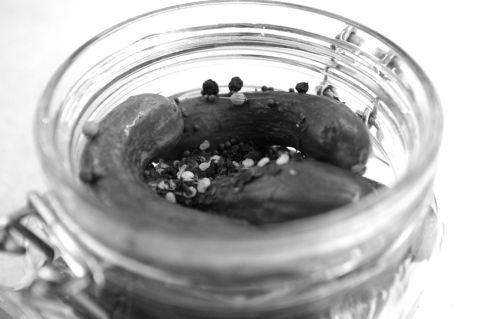pickles
June 23, 2013 § Leave a comment
Without meaning to belabour the point, winter is an exciting time in the top end. Really it is like summer down south and the vegies that grow this time of year are proof of that. We have four cucumber plants in pots under the verandah in anticipation that they will provide some edible shade in the coming months. But in the meantime, I have been getting them from the markets, small and sweet, straight from the local growers at Humpty Doo.
And I know I have mentioned this to you before, but I do love pickles. Crunchy, tart, sour, salty. In true wholesome, traditional and healthy fashion, I have provided you with an old recipe for making pickles, one that uses ancient methods of fermentation and preservation. This way you get all those wonderful lactobacillus which I have been told, on countless occasions by my mother, – are very very good for you. And mothers are always right.
If you want a recipe for pickles that tastes like those you buy in the shops you will need to look elsewhere. Inspired by Jenny at Nourished Kitchen, this recipe uses salt rather than vinegar and as a result, the lacto fermentation process. But still, below I have given you two options for making brine. The first is exclusively with salt and the second is with less salt and a small amount of apple cider vinegar. You can decide which version you like the best.
Lacto fermented pickled cucumbers
For pickling, try to use freshly picked cucumbers if possible, but if not, get ones that are organic and as fresh and small as you can find. Say no more than 2 inches long.
Ingredients
Enough pickling cucumbers to fill your jar(s).
4 cloves of fresh organic garlic – per 500ml jar
1 tsp spices (for example, allspice, mustard seeds, bay leaf, black pepper, dried chilli flakes etc) – per 500ml jar
Optional – Use 1 fresh grape-vine leaf with the stem removed or a horseradish leaf per 500ml jar. This will help your pickles to stay crisp when the lactic acid fermentation is complete.
Brine
Option 1: 2 ½ – 3 tablespoons of salt per 4 cups of chlorine free filtered water
Option 2: 1 tablespoon of salt and 2 tablespoons apple cider vinegar for every 3 cups of chlorine free filtered water.
(1 cup of brine usually fills a 500ml jar)
Method
If you were unable to pick your cucumbers fresh, the first thing you will need to do is soak them in very cold icy water to perk them up before they ferment. Next, you’ll want to make sure all stems and flowery ends have been removed as they may give an off-flavor to the pickles. I generally cut a tiny scrape off the ends of each cucumber with a knife to be certain. It is also important that each cucumber is cleaned carefully. These steps will help ensure your pickles remain crunchy.
Place the pickling cucumbers, garlic and spices in sterilised jars in layers and ensure that they are a snug fit but without damaging the cucumbers. Add the horseradish or grape-vine leaf if you have it.
Prepare your brine. Shake or stir to help the salt fully dissolve. Pour the brine over the pickling cucumbers, until all of the ingredients are submerged. It is important that all of the ingredients are covered with the brine, and if necessary add a clean weight into the jar to help push them under the liquid, for example, a small plastic lid. Secure the lid and allow to ferment at room temperature for between 5 and 10 days, depending on your climate. The cooler it is the longer it will take. Once they are ready, store in the fridge to be eaten as you please.
As a side, I know it can be a fear with people, as it was with me, to be uncertain about whether your ferments are off. All I can say is, trust me, you will know. The smell is bad enough that you won’t want to touch them.



